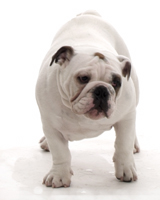| |

|
|
Keeping Children Safe
Most dog related injuries happen to children in their own home or the home of a relative or a friend and are inflicted by a dog they know.
When a dog is around, small children should be supervised at all times because
- they can unwittingly provoke an attack, for example by trying to take a bone away from a dog, hugging or kissing it
- dogs might get excited by games being played and jump on or chase a child
- a child's height in relation to a dog means that children are often bitten on the face, head and neck, and are therefore more likely to suffer serious injuries
- dogs might try to dominate a child because of a child’s small size.
Children should be taught basic safety habits around dogs, with parents and caregivers showing the way.
Be extra careful with toddlers
Toddlers are especially vulnerable because of their small size, and lack of understanding of risks and instructions. Small children should be closely supervised at all times around dogs. Toddlers should not be allowed to
- be around dogs, including puppies, without adult supervision
- put their face down to a dog’s face, hug or kiss it
- play with a dog’s food, feeding bowl, toys or bedding
- wander into neighbouring properties where there might be dogs.
Supervise dogs and children
Your dog is a pack animal and it may try to assert its place in the family pack by showing aggression, mouthing or even nipping the smallest and most vulnerable member. Always supervise children and dogs when they are together.
- remember any dog that is provoked or frightened could growl, snap at, or bite a child
- young children learn by example, so adults should model safe behaviour with dogs.
- put your dog in another room on occasions such as children's parties where it could become over excited
- do not allow children to tease the dog either physically or verbally
- children should not be allowed to shriek and leap around a dog as it may cause the dog to react badly. Similarly do not let a child sit on a dog or grab its tail
- keep children away from a dog that is sick, tired or has puppies
- socialise your dog with children
- don’t let children tease your dog, hurt it, tightly hug it or put their faces close to its face
- do not let a small child pick up or carry a puppy, it may squirm and fall or bite in an effort to get away
- if you are concerned by a visiting child’s unsafe behaviour around your dog, separate them and explain your concern to the child’s parent or caregiver
- ensure your dog is under your control at all times around children, it must respond quickly to commands including "Sit", "Stay", "Drop", "No" and "Come".
Socialising a dog into a household with children
If you are going to get a new puppy or adult dog there are some things you can do to help the new arrival fit in safely with your family
- if you have children in your household, it’s sensible to select a breed that has a good reputation as a family pet
- puppies will instinctively try to work out their place in the pecking order by mouthing, biting and rough play. It’s important to establish your and your children's dominance early on, through good training, so dominant, aggressive behaviour does not become entrenched
- start teaching your children dog safe behaviour before your new puppy or dog arrives. For more information, see Keeping Children Safe, and Dog Safety For Kids. If you are thinking of getting an older dog, it’s sensible to assess how well it is socialised to children, before you decide to take it
- don't expect the dog to be patient with your child unless you have taught it how to behave
- involve your children with training and feeding the puppy or dog, to reinforce that children are higher in the pecking order than the dog.
Making adjustments for a new baby in your household
If you are bringing a new baby into your household, you might need to change some routines your dog is used to:
- train your dog not to enter the baby's room
- introduce your dog gradually to the new baby
- stop any rough or aggressive behaviour
- reward gentle, good behaviour - make the new baby a pleasant experience by rewarding your dog with praise or treats when it is well-behaved around the baby.
If you haven’t got a dog you may wish to delay getting one until your child is old enough to understand how to behave around a puppy or dog.
|

